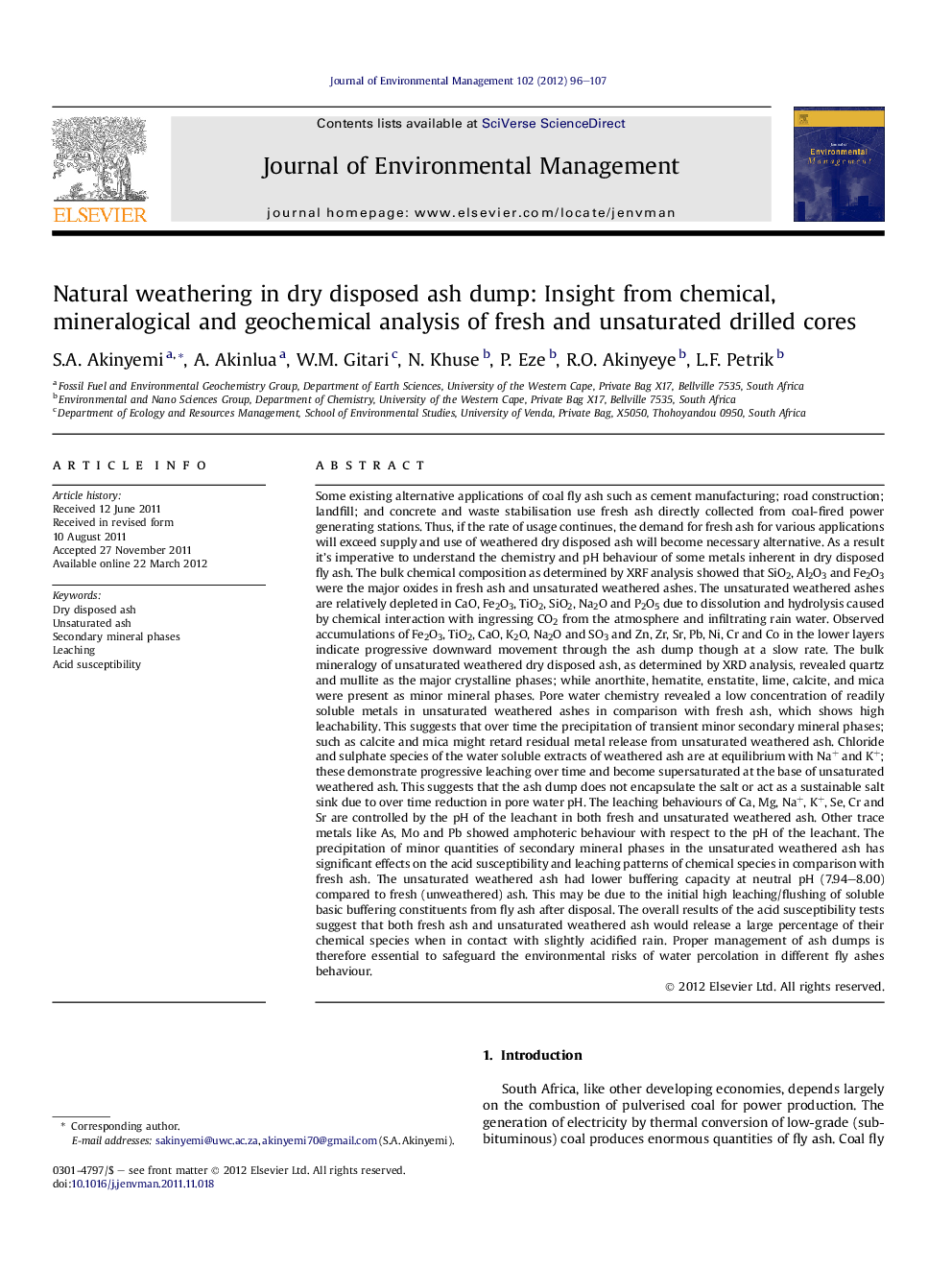| Article ID | Journal | Published Year | Pages | File Type |
|---|---|---|---|---|
| 1056817 | Journal of Environmental Management | 2012 | 12 Pages |
Some existing alternative applications of coal fly ash such as cement manufacturing; road construction; landfill; and concrete and waste stabilisation use fresh ash directly collected from coal-fired power generating stations. Thus, if the rate of usage continues, the demand for fresh ash for various applications will exceed supply and use of weathered dry disposed ash will become necessary alternative. As a result it’s imperative to understand the chemistry and pH behaviour of some metals inherent in dry disposed fly ash. The bulk chemical composition as determined by XRF analysis showed that SiO2, Al2O3 and Fe2O3 were the major oxides in fresh ash and unsaturated weathered ashes. The unsaturated weathered ashes are relatively depleted in CaO, Fe2O3, TiO2, SiO2, Na2O and P2O5 due to dissolution and hydrolysis caused by chemical interaction with ingressing CO2 from the atmosphere and infiltrating rain water. Observed accumulations of Fe2O3, TiO2, CaO, K2O, Na2O and SO3 and Zn, Zr, Sr, Pb, Ni, Cr and Co in the lower layers indicate progressive downward movement through the ash dump though at a slow rate. The bulk mineralogy of unsaturated weathered dry disposed ash, as determined by XRD analysis, revealed quartz and mullite as the major crystalline phases; while anorthite, hematite, enstatite, lime, calcite, and mica were present as minor mineral phases. Pore water chemistry revealed a low concentration of readily soluble metals in unsaturated weathered ashes in comparison with fresh ash, which shows high leachability. This suggests that over time the precipitation of transient minor secondary mineral phases; such as calcite and mica might retard residual metal release from unsaturated weathered ash. Chloride and sulphate species of the water soluble extracts of weathered ash are at equilibrium with Na+ and K+; these demonstrate progressive leaching over time and become supersaturated at the base of unsaturated weathered ash. This suggests that the ash dump does not encapsulate the salt or act as a sustainable salt sink due to over time reduction in pore water pH. The leaching behaviours of Ca, Mg, Na+, K+, Se, Cr and Sr are controlled by the pH of the leachant in both fresh and unsaturated weathered ash. Other trace metals like As, Mo and Pb showed amphoteric behaviour with respect to the pH of the leachant. The precipitation of minor quantities of secondary mineral phases in the unsaturated weathered ash has significant effects on the acid susceptibility and leaching patterns of chemical species in comparison with fresh ash. The unsaturated weathered ash had lower buffering capacity at neutral pH (7.94–8.00) compared to fresh (unweathered) ash. This may be due to the initial high leaching/flushing of soluble basic buffering constituents from fly ash after disposal. The overall results of the acid susceptibility tests suggest that both fresh ash and unsaturated weathered ash would release a large percentage of their chemical species when in contact with slightly acidified rain. Proper management of ash dumps is therefore essential to safeguard the environmental risks of water percolation in different fly ashes behaviour.
► The weathered ash cores exhibit lower buffering capacity than fresh ash from the same power station. ► XRF results reveal leaching of the ash major soluble matrix due to long-term chemical weathering. ► The leaching behaviours of Ca, Mg, Na+, K+, Se, Cr, and Sr are controlled by the pH of the leachant in both fresh and weathered ash. ► The progressive downward leaching of Na+, K+, Cl− and SO42− suggest that the ash does not encapsulate salt or act as a sustainable salt sink. ► Management issues such as continual brine irrigation and lack of proper records of salt loads put on the ash dump need improvement.
